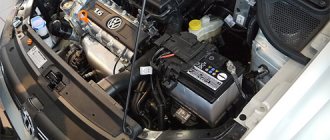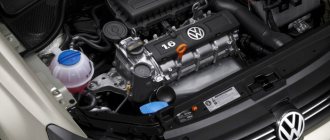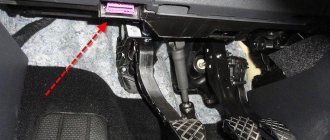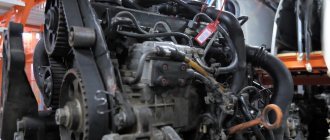After entering the market, the Volkswagen Polo sedan became a real bestseller for a number of reasons. A well-known brand, modern interior and exterior design, reliable and economical engines, as well as a good level of equipment and safety at an affordable price ensured that the model was in wide demand.
Moreover, the budget car, like the more respectable models of the brand, also received a choice of transmissions. In addition to the traditional manual transmission, an automatic transmission on the Polo sedan can be installed in any configuration.
Next, we will look at the advantages of the Polo sedan version with automatic transmission, which automatic transmission is installed on this car, and also what to look for when choosing a Polo sedan model with an automatic transmission.
Polo sedan automatic transmission
So, as you know, when choosing cars from the budget segment, many car enthusiasts strive to purchase the most reliable equipment. At the same time, the key to long-lasting and trouble-free operation of all units is their simplicity in design (a proven engine that is unpretentious in terms of fuel quality, a manual transmission and a minimum of complex technical equipment).
As for the automatic transmission, in the CIS, car enthusiasts consider such a box to be complex, expensive and unreliable, that is, they are in no hurry to change the manual to an automatic. It is also generally accepted that a car with an automatic transmission consumes more fuel and accelerates worse. There is partly some truth in this, especially when it comes to old 4-speed automatic transmissions of previous generations.
Let us immediately note that today the situation has changed somewhat. First of all, modern automatic transmissions have 5 or more gears, and can also be even more economical than manual ones. Also, actively working electronics and a number of additional functions and automatic transmission modes allow such a box to confidently compete with manual transmissions.
- The Polo sedan was no exception, since Volkswagen offers this car with a modern automatic transmission. On the Polo sedan, the Aisin automatic transmission is a reliable “classic” hydromechanical automatic (especially in comparison with AMT or DSG).
The specified box 09G (Tiptronic) is a 6-speed automatic transmission (VAG classification 09G, 09K and 09M), installed not only on Polo, but also on other VAG brands and models (for example, Audi A3). The box has an Aisin AW: TF-60SN valve body. The device has been modified, the valve body valves have received brass bushings.
Volkswagen Polo with automatic transmission
The Volkswagen Polo is equipped with three types of gearboxes: automatic, mechanical and robotic. The most reliable is considered to be a manual transmission, which compares favorably with others in its durability and ease of maintenance. The robotic gearbox is not so reliable and is a transitional option between manual transmission and automatic transmission. According to reviews of the Volkswagen Polo hatchback, the automatic transmission provides maximum driving comfort, but at the same time requires large investments in the event of a breakdown. Car owners prefer Polo models with Tiptronik automatic transmission, which operates in manual and automatic modes.
Similar automatic transmissions are installed on fifth-generation cars equipped with 1.6 MPI engines. In Europe, only restyled hatchbacks of the fourth generation, produced since 2005, were equipped with such a transmission.
Automatic transmission on Polo sedan: pros and cons
Like any other unit, the automatic transmission on the Polo sedan has both advantages and disadvantages. Let's start with the positives. First of all, the advantages of an automatic transmission include a significant increase in comfort.
Taking into account the fact that there are 6 gears, the presence of the Tiptronic manual mode also allows for dynamic driving (you can always select a lower gear when overtaking, the car is easier to drive in winter on snow, etc.) It is important to consider that budget cars rarely get 6-speed gears. A three-speed, full-fledged automatic transmission, that is, a compact and relatively inexpensive Volkswagen Polo sedan with an automatic transmission is in no way inferior to more “adult” models.
Owners also note increased acoustic comfort compared to a manual transmission, since the 6-speed automatic selects the optimal moments for gear changes. Thanks to this, the service life of the engine paired with an automatic transmission can be slightly increased.
We also recommend reading the article on how to change the oil in an automatic transmission Polo sedan. From this article you will learn when and why you need to change the oil in an automatic transmission, as well as how to change the oil in a Polo sedan automatic transmission.
It is also noteworthy that in practice a car with an automatic transmission turns out to be no less dynamic than a manual Polo sedan. This is proven by the numbers and acceleration to “hundreds”, where the version with automatic transmission loses by only 1 second.
At the same time, the Polo sedan with an automatic transmission and a 6-speed automatic transmission turned out to be very economical. This automatic transmission increases fuel consumption by only 0.5 liters of fuel per “hundred” compared to a manual transmission. In other words, if old automatic transmissions increased consumption by 15-25%, a modern automatic transmission in this regard is practically no different from a manual transmission.
- Now about the disadvantages that also exist. As you know, an automatic transmission requires constant monitoring and regular maintenance. You should also avoid heavy loads on the transmission (sharp starts from a standstill, constant driving in kick-down mode, high engine speeds in manual mode, slipping, towing trailers and other cars, etc.).
This automatic transmission also needs to be warmed up before driving, and until the unit warms up, you need to drive in a gentle mode, gradually accelerating the car. As for the main disadvantages, a common problem with the automatic transmission in the Polo sedan is overheating of the automatic transmission.
The transmission simply doesn't have enough of the factory heat exchanger to keep it cool. The oil in the automatic transmission gets very hot, especially in the heat when driving around the city. The result is a decrease in pressure, oil starvation, accelerated wear, and rotation of the bimetallic sliding bushings of the oil pump and individual elements of the planetary gear set.
Also among the problems of this automatic transmission, owners note the main pressure regulator in the valve body. A malfunction of this kind leads to the fact that gear shifts are accompanied by jerks, jolts, and the automatic transmission jerks and kicks.
Sometimes slipping occurs when changing gears (both in low and high gears). At the same time, the official service often offers to immediately replace the valve body, since the main argument is problems with finding spare parts. Naturally, for cars that are not under warranty, the cost of such a replacement is quite impressive. By the way, you can fix problems with third-party services without replacing the hydraulic plate, but the procedure is also not cheap.
Specifications
Volkswagen Polo belongs to the budget category, but has good technical characteristics. Car enthusiasts are offered a choice of two engines with a volume of 1.6 liters and a power of 85 and 105 horsepower. Reviews of the Volkswagen Polo automatic note the good dynamics of the car: with an automatic transmission and a 1.6-liter engine, acceleration to hundreds takes 12.1 seconds, top speed is 190 km/h. The maximum torque at 3800 rpm is 153 Nm. At the same time, the consumption of a Volkswagen Polo with an automatic transmission in the combined cycle is 6.5 liters.
The 85 horsepower engine does not guarantee good dynamics and is intended for measured driving in the city. The maximum engine torque at 3750 rpm is 145 Nm. The car accelerates to 100 km/h in 11.9 seconds. It is installed in tandem with a five-speed manual transmission.
Why not DSG-7 (lots of text) - logbook of the 2020 Volkswagen Polo Sedan GT Сoca-Pola on DRIVE2
Hi all!
As the title suggests, in this post I will talk unflatteringly about the DSG-7 box, also labeled DQ-200, based on some articles and my Drive2 analysis of the breakdown of these “beautiful boxes.” I immediately write that the post does not apply to those who want to sell a car before the end of the warranty, as well as to those who know all this but at their own peril and risk decided to play with fate.
Yes, I understand that fans of this “new round of transmission development” will throw feces at me, but still you need to know something:
DSG-7, also labeled DQ-200, is a junior version of the six-speed DSG-6, but unlike the preselective six-speed gearbox, in which the clutch unit is in an oil bath, the DSG-7 remains a “dry” gearbox.
– As you understand, the word “dry” is used here for a reason, as if hinting that you guys will be riding “dry.”
The diagram shows a six-speed and seven-speed DSG gearbox. It can be seen that the “seven” has noticeably lost weight – 77 kg versus 93 kg for the “six-speed”. This was achieved by getting rid of the powerful oil pump, which no longer needs to push 6-7 liters of working fluid. And the very fact that there was less oil allowed me to get rid of 4-5 kg of excess weight.
This box was deprived of the oil bath, which performed lubricating and cooling functions, and the mechatronics servos were transferred from constant operation to activator mode. The gearbox has become much cheaper and lighter, otherwise remaining the same DSG-6. If in the DSG-6 its volume is 6.4 liters, then in the “dry” DSG-7 this figure is 1.9 liters. Considering that instead of two standard shafts there are already three in the box, it turns out that oil reaches the third shaft only in the form of splashes. And this is nothing for a car that is used on the highway, but for urban conditions, with constant load on the gears, this becomes a serious problem.
– I think that the main criterion was to make the box cheap, since it’s unlikely that 16+ kg will play a role. Here's some theory:
The DSG-7 is a manual gearbox with double clutch and automated control, which is controlled by the mechatronics unit. The double clutch works in such a way that while the synchronizer grabs the gear on the shaft with even gears, at the same moment another synchronizer locks the gear on the shaft of odd gears, thereby avoiding clutch breakage when shifting to a higher gear.
– I think everything is clear here, everyone knows the principle of operation, but here’s an interesting fact:
The engineers developing the DSG-7 managed to cram about 400 parts into a box whose dimensions did not exceed 40 cm. But the other side of the coin turned out to be that the extremely complex design was, firstly, expensive to manufacture, and secondly, even more expensive to maintenance, and thirdly, a box with such a small flywheel could “swallow” only 250 Nm of torque. – 250 maximum - I think it won’t care about your chip, it’s already straining a lot. If you look at the chip from Revo, they promise 250Nm, which means that the box will operate at its limit, which, as you understand, should not be done. The situation when the box is working at the limit of its capabilities, I tested it on FF2 - the box remains on the floor (even the mechanics), sometimes along with the radiator, which it pierced.
– A little about mechatronics of the “new round of transmission development”:
The mechatronics unit works like an automatic machine that reads data about the speed and operation of the engine, selects the right moment and sends a signal to the servos to change gears. The mechatronics unit also came out as not the most reliable unit - updated firmware for its operating system over six years of operation of cars with DSG- 7 neither one nor two came out. In order not to be unfounded, here are statistics taken from the website of Volkswagen Golf car owners - vw-golfclub.ru. In a survey in which 12,000 people have so far taken part, when asked whether there was a DSG breakdown in your car, 91% answered that there was a breakdown, and only 9% that there was not.
– Isn’t it a bit of a harsh reality?..
Full size
Mighty three letters
Cars with DSG-7 were plagued by the same misfortune - the trip was accompanied by constant jerks and bumps, and this was with a mileage of less than 20,000 kilometers. The main complaint about the DSG is increased clutch wear. The most common primary symptoms are vibration, jerking, jerking and a characteristic metallic clanging sound when shifting gears from first to second, or from second to third. There are known cases when, due to this problem, owners of Volkswagen cars had to contact service after a mileage of 2-3 thousand kilometers.
Having read all this and people’s posts about their DSG-7 box, I identified the main disadvantages of this box, except for reliability: 1. Jerking when shifting gears up or down is the most common problem. It is caused by the fact that the dry clutch discs close too abruptly. The effect is approximately the same if, on a manual car, you release the clutch pedal when shifting.
2. Extraneous sounds during operation. Clanking, grinding and other noises.
3. Loss of traction during acceleration. The clutch plates do not engage each other properly and the car becomes unresponsive when pressing the gas pedal. The situation is especially dangerous when overtaking on country roads.
I would also like to note that the box does not have any predilections for driving, that is, no matter how you drive, drive or drive stupid, it can crumble both after 10,000 km and after 100,000 km. That's all I have... Kick with your feet.
Issue price: 100,000 ₽ Mileage: 1050 km
www.drive2.ru
Reviews
Vladimir, 26 years old, Tver: I purchased a Polo sedan with a fourth-generation automatic transmission with a mileage of 62 thousand km five years ago. I used it constantly, mainly in city mode, and twice a year I went on long trips along the highway to the sea. There were no problems with the gearbox, I constantly filled in new oil every 40-50 thousand km, always changed completely and cleaned with mineral additives. It was only 340,000 km before the first failure of two gears. The Tipronik AT-6 box is a reliable unit.
Igor, 28 years old, Moscow: I’ve been driving a Polo with an Aisin automatic transmission for more than three years. At the beginning of the journey, I was under warranty service twice due to automatic transmission problems. I bought the car new from the dealership. The first time there was unbalance of the fastenings, strong vibration in the cabin - they fixed it without any complaints. The second time, at about 92,000 miles, the torque converter completely failed. The purchase and replacement cost 16 thousand rubles. The service department said that it most likely broke down because it did not warm up the box in winter before traveling - and that was true. Overall, I'm happy with the automatic on the Polo.
Nikolay, 30 years old, Vladivostok: After 120,000 miles, jumps constantly occur in 5th and 6th gears. I drive on the highway only in manual mode. I went for diagnostics, they said everything is fine so far, but resets sometimes appear in automatic mode. The car is new.
Ruslan, 26 years old, Nizhnevartovsk: The only complaint about the Polo machine is that it’s slow. If the drive to the accelerator is electronic, then it will be even slower. Although I have driven a BMW before and compare it with it.
Timur, 31 years old, Tomsk: Fuel consumption on the highway with a Polo automatic showed 5.9 liters per hundred km. In reality, this is true, if you don’t drive too hard. The box is gorgeous, I like that you can choose manual mode.
V generation VW Polo
The fifth generation of Polo was presented in 2009. Especially for the Russian market near Kaluga, a Volkswagen Polo sedan with an automatic transmission began to be produced in 2010, which made the car more affordable and ensured its expansion into the country's market in the B-segment.
During production, the model has evolved from an economical small car to a compact and stylish car with wide functionality and a rich package of options.
You might be interested in:Hymer motorhome: unnecessary luxury or comfort?
Cons of the Volkswagen Polo
The interior, although well assembled, is nothing outstanding: it is plastic, inconspicuous, ascetic and as budget-friendly as possible. The seats creak and become loose: due to cheap materials, the seats cannot withstand heavy drivers on bad roads.
The Polo doesn't drive as well as other Volkswagen models. It lacks German handling and “animal” stability on the road. Although hatchbacks, on the contrary, are typical representatives of Volkswagen taxiing. But in our market they are rarely found.
“Polo” got both disc and drum brakes at the same time. Because of this, overbraking occurs on the rear wheels. ABS is then disabled. The vacuum booster of the brake pedal often leaks: the driver presses on the “brake” like crazy, but the car is in no hurry to stop.
The engine is noisy and weak. The low-power 1.6-liter engine is enough to work as a taxi driver and drive through traffic jams. It won't be useful for anything else.
Noise insulation is not provided in the Volkswagen Polo. You can hear the engine and arches from the front, and the suspension is still knocking from the rear. After 80 km/h you can hear the engine, the air, the creaking of seats, and the tires.
On cars that have traveled hundreds of thousands of kilometers, door harnesses and power window drives are often broken. Multimedia and alarm systems are not available in the basic configuration, so the owners “farm” and install equipment from third-party manufacturers. And this does not benefit the Polo's electronics - it is not reliable enough to withstand many connected additional devices.
Surprisingly, the Polo's manual transmission is less reliable than an automatic transmission. The clutch “burns” already by 60 thousand km, and by 100 thousand it loses oil.
The main problems of the Volkswagen Polo are concentrated in electronics, brakes and budget. If you don’t know what normal cars can be like, you might not notice how modest the Polo is.
Mandatory maintenance work
DSG 7 Volkswagen Polo repair
To ensure that Volkswagen Polo automatic transmission repair is not required prematurely, you should use the transmission fluid recommended by the manufacturer and regularly check its cleanliness. In addition, oil starvation, which occurs due to wear of sealing elements or solenoids, must not be allowed. When the oil level is critically low, the mechanical parts of the automatic transmission overheat and wear out quickly. This also causes malfunction of the valve body and torque converter.
How to check the volume and condition of the oil
Volkswagen has equipped its budget sedan with a special probe. Basically, this measuring device is designed to measure the oil level in the traditional way. So, there is a Min mark on the dipstick, which indicates the minimum permissible level of oil that is still left in the gearbox. If the fluid is below the mark, then topping up will be required. It is necessary to top up until the consumable reaches the maximum mark on the dipstick (Max). In case of overflow, you will have to drain some oil, and to do this you need to crawl under the car, having first installed the car on supports, a jack or a lift. This procedure takes a lot of time, so overfilling the oil is highly undesirable.
Before adding oil, you need to make sure it is in good condition. Checking the oil condition should be performed at least once a week, and preferably together with checking the oil level. Plus, it's much more convenient. If it is discovered that the liquid emits a specific odor, smells burnt or has a dark brown color, then adding oil alone will clearly not be enough. The fact is that in this state the liquid has most likely already lost all its beneficial properties. In addition, bad oil can be identified by the presence of floating metal shavings. In addition, a sediment with mud deposits appears at the bottom of the used oil. In this case, it is important to change the oil as soon as possible. It is possible that the oil will expire even with low mileage - due to the harsh climate and bad roads. Russian drivers sometimes have to subject their car to high loads - this is rather a necessity caused by the peculiarities of the Russian climate. Local car enthusiasts prefer to change the oil every 40-45 thousand kilometers. The shorter the replacement interval, the greater the confidence in the reliability of the gearbox.
So, if the above-mentioned signs (smell, color) are detected, the old oil must be urgently drained and then filled with flushing fluid. This involves a complete oil change - flushing with a special product ensures comprehensive cleaning of the gearbox from deposits and contaminants, including metal shavings. After this, the used flushing is drained, and new fluid is poured into the empty transmission in full.









